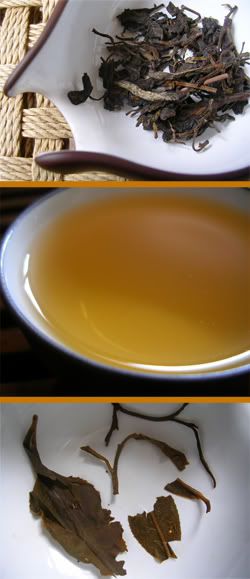As yesterday, these samples will remain anonymised until all results are in. I am planning to publish the conclusions of the event next week-end, and so for those few tasters left yet to taste, do send your notes by then if you'd like them included (but do not feel obliged to do so).
Brewing parameters for all three samples are identical:
~10cl of Caledonian Springs @ 100C in 20cl shengpu pot; ~5g of leaf; 1 rinse
Sample D
 Dry leaves:
Dry leaves:Long, whole leaves, with a large number of yellow (usually suspicious) leaves. A nondescript aroma of generic pu'er lingers. The compression is very loose, almost maocha. I found the leaves' appearance rather pretty - what say you?
12s, 15s, 20s:
You may note just three infusions were made - not a favourable sign. The initial infusion had a sticky, sugar lengxiang which rapidly vanished in subsequent brews.
This leaf tastes very young, with plenty of ku from the mid-taste onwards to the throat - this lingers, but there is little patience in the fragile, quiet sweetness that constitutes the flavour.
The ku is strong in later infusions, almost becoming raggedly so - like a speaker turned up louder than its quality can handle.
Wet leaves:
Hand-picked, whole, and pleasant. Some red edges from bruised leaves. Very green.
Overall:
Thin and not very interesting, this tea was at least energetic - my arms and throat flushed with warmth. There was little flavour, complexity, or presence to arouse my attention.
Sample E
 Dry leaves:
Dry leaves:Dark and matted. Broken leaves of all grades. This does not bode well.
12s, 15s, 30s:
A murky, yellow soup. The wenxiangbei is interesting, opening with something like the contents of a stable (sharp, deep straw), and ending in a sickly-sweet lengxiang.
More drinkable than D, this had a tang running through it similar to artificial sweeteners - something edgy, like saccharin. No huigan to be found, nor presence in the nose, this tea is muted in all ways. It is a harmless background tea while I unwind with "Blood On the Tracks".
The final infusion was a failed attempt to coax out some flavour, which seems to be largely absent.
Wet leaves:
Plenty of stems, with a mess of broken sections, from many sizes.
Overall:
Drinkable, and yet so bland that I found my mind wandering away from the tea-table. I detect no character of yesheng [wild] leaves. This tea has prejudiced me against Jiangcheng factory, of which this is their first product I have encountered.
Sample F
 Dry leaves:
Dry leaves:Looking somewhat akin to a Wuyi yancha, it is twisted and dark. It has the gentle aroma of nothing in particular.
12s, 20s, 25s:
The soup was a strong orange, initially causing concern of overbrewing; however, the taste was very quiet. A little tanginess, but a truly noteworthy absence of absolutely any else: no huigan, no patience, no nose, no sensation, no flavour, no chaqi. It is a warm cup of "something", after many hours spent with research. VL's kind provision of the Fratres by Arvo Part rings out the death-knell for this tea.
Wet leaf:
Rather pretty little leaves, like nettles. They are very pale, which perhaps explains the lack of detectable characteristics in this tea.
Overall:
Apart from a monotonic, constant ku, one could be forgiving for thinking that they were drinking warm melon juice.
This is the product of over-farming, and I would very much like to sit down with the farmers responsible and have them drink their own tea. The high price of maocha has led to many ills, and teas like this are certainly among them.

4 comments:
The picture of the wet leaves for D has all sorts of alarm bells ringing. The leaf with the small base that widens to a wide tip... looks like benshan!
when you say publish, do you mean to say on your blog, or are our notes going to get some air on the teacuppa site?
-Ian
LZ,
Aren't they odd? They look like the vineleaves you get here. This tea had a lot of yellow in, as you might be able to see in the photograph - it makes for pretty but unpleasant tea. :)
Ian,
I meant just here - I was going to post a summary thread to pull together the various opinions. There is a general consensus, so far (6-7 tasters).
Toodlepip both,
Hobbes
Well.... benshan is.... what they use to fill up low grade tieguanyin.
Post a Comment